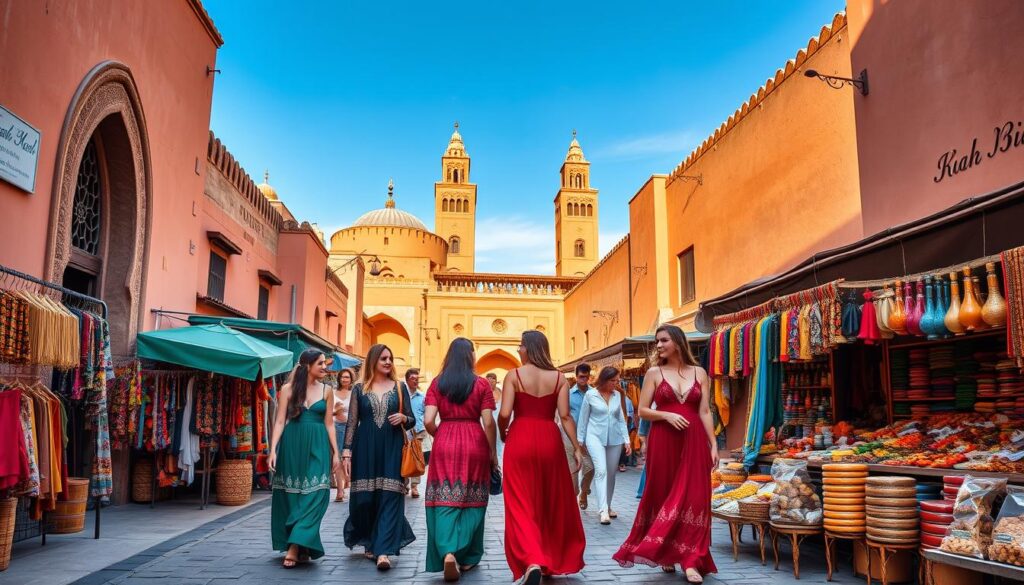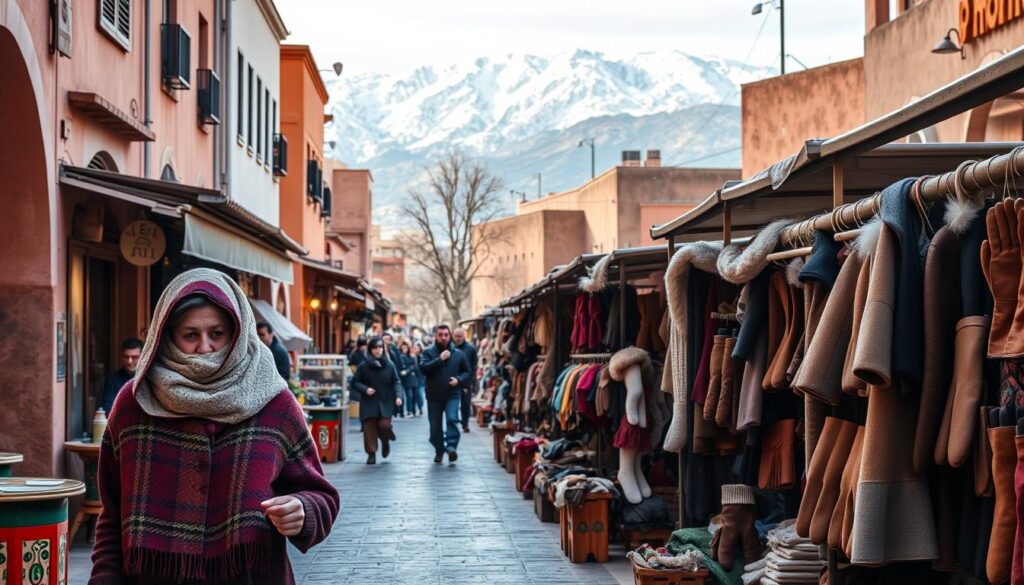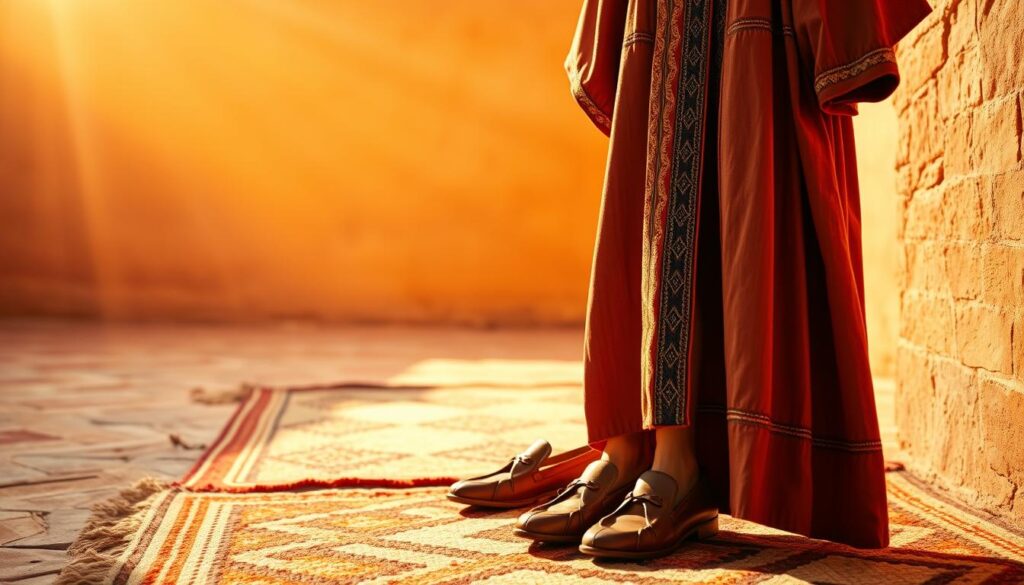Are you planning a trip to Morocco but wondering how to pack for the diverse climates and cultural norms? Morocco’s unique blend of traditional and modern influences can make choosing the right attire a challenge.
As a Muslim-majority country, Morocco encourages tourists to dress modestly, especially when visiting rural areas or religious sites. With the surge in affordable flights, travelers from around the world are discovering Morocco, but may not be familiar with the local customs.
Understanding the local culture and dressing appropriately can enhance your travel experience, helping you blend in and avoid unwanted attention. For personalized assistance with your Moroccan adventure, contact Morocco Disney Tours at +16823085820 or [email protected].
Key Takeaways
- Pack versatile clothing for diverse climates and cultural norms.
- Dress modestly, especially in rural areas and religious sites.
- Consider the season and region when choosing your attire.
- Balance comfort and cultural respect in your clothing choices.
- Understand local customs to enhance your travel experience.
Understanding Moroccan Dress Culture
Moroccan dress culture is a complex tapestry woven from Islamic traditions, modern influences, and regional variations. The country’s unique cultural heritage is reflected in the diverse ways people dress, making it essential for tourists to understand these nuances to navigate Morocco with respect and ease.
Cultural Sensitivity and Local Customs
Morocco is a Muslim-majority country, and its dress culture reflects this heritage. While female tourists are not required to cover their heads, dressing modestly is appreciated. This means covering shoulders, knees, and chest. Understanding and respecting local customs through appropriate dress demonstrates cultural sensitivity and enhances interactions with local people during your Moroccan journey.
The level of conservatism in clothes varies by region. Coastal areas and tourist destinations tend to be more relaxed, while rural villages maintain more traditional dress expectations. Tourists should be aware of these regional differences to pack appropriately and avoid unwanted attention.
How Locals Dress in Different Regions
The way locals dress in Morocco varies greatly across different regions. In urban areas like Casablanca and Marrakech, women wear a mix of traditional and modern clothes, including djellabas (hooded robes) and Western-style attire. In contrast, rural areas tend to be more conservative, with women often wearing traditional clothing that covers their hair and body.
Men’s clothing also varies, with some wearing traditional gandouras (loose, long-sleeved tunics) and small caps called taqiyah, while others prefer modern, Western-style clothing. Understanding these regional differences helps travelers pack appropriately and show respect for local customs.
What to Wear in Morocco: General Guidelines
When traveling to Morocco, understanding the general guidelines for dressing is crucial for a respectful and enjoyable trip. Morocco is a country with a rich cultural heritage, and dressing appropriately is a sign of respect for local customs and traditions.
The key to dressing in Morocco is modesty. Keeping shoulders, knees, and chest covered is a general rule that applies to both men and women, regardless of the season. This means avoiding low-cut tops, short shorts, and form-fitting clothes, especially when exploring medinas, visiting religious sites, or traveling to rural areas.
Modesty Standards for Tourists
For women, it’s advisable to avoid revealing clothing. Loose-fitting, breathable fabrics are not only more modest but also offer comfort during the hot summer months. Men should also dress modestly by wearing long pants or longer shorts that cover the knees and avoid going shirtless except at designated areas like beaches or hotel pools.
As a tourist, being mindful of your attire is not just about following rules; it’s about showing respect for the local culture. This includes dressing more conservatively when visiting religious sites or rural communities, and being particularly mindful during Ramadan.
Balancing Comfort and Respect
Finding the right balance between comfort and cultural respect is essential. Layering clothing is a practical approach, allowing you to adjust to different environments, from air-conditioned interiors to hot streets, and from daytime heat to cooler evenings.
| Dress Code | Recommended for | Avoid |
|---|---|---|
| Modest clothing covering shoulders, knees, and chest | Both men and women, all seasons | Low-cut tops, short shorts, form-fitting clothes |
| Loose-fitting, breathable fabrics | Hot summer months | Thick, heavy fabrics |
| Layered clothing | Variable weather conditions | Single-layer clothing |
As one travels through Morocco, it’s clear that dressing appropriately is not just a matter of personal choice but also a sign of respect for the host culture. By dressing modestly and being mindful of local customs, tourists can enhance their experience and demonstrate consideration for local sensibilities.

Summer Clothing Essentials for Morocco
The scorching Moroccan summer requires careful selection of clothing to ensure both comfort and cultural sensitivity. When visiting Morocco during the summer months, the temperature can soar above 100°F (38°C), making it vital to pack wisely.
Breathable Fabrics and Styles
Choosing the right fabric is crucial for comfort in Morocco’s summer heat. Breathable, natural fabrics like cotton, linen, and lightweight rayon are ideal. These materials allow for airflow and help keep you cool. Loose, flowy dresses that cover the knees are perfect for women, offering both comfort and modesty.
Recommended Outfits for Hot Weather
For both men and women, lightweight and breathable clothing is recommended. Men should opt for lightweight shirts with sleeves and longer shorts or lightweight pants. Women can wear long dresses or skirts that are not too tight. Light-colored clothing is preferable as it reflects heat better than dark colors.
| Clothing Item | Recommendation |
|---|---|
| Tops | Lightweight, breathable shirts with sleeves |
| Bottoms | Longer shorts or lightweight pants for men; long dresses or skirts for women |
| Footwear | Comfortable, closed-toe sandals |
Sun Protection Must-Haves
Protecting yourself from the sun is crucial in Morocco’s summer. Wide-brimmed hats, quality sunglasses, and high-SPF sunscreen are daily essentials. A light-colored scarf can also provide relief from the sun by protecting your scalp.
“The key to enjoying Morocco in the summer is dressing appropriately for the heat while respecting local customs.”
By choosing the right clothing and accessories, you can ensure a comfortable and enjoyable trip to Morocco during the summer months.
Winter and Fall Packing List
As winter and fall arrive in Morocco, the temperature drops, especially in the mountains and northern regions, necessitating warm and layered clothing. During these seasons, the weather can be quite chilly, particularly in the mornings and evenings.
Layering Strategies for Cooler Months
Layering is essential during the fall and winter months in Morocco. It’s advisable to pack thin base layers, mid-weight sweaters, and a waterproof outer layer that can be adjusted throughout the day as temperatures fluctuate. This strategy allows for flexibility and comfort across different environments and activities.
- Include thermal underlayers for colder evenings, especially if you plan to visit desert regions or mountainous areas.
- Choose pants made of heavier fabrics like cotton twill or wool blends for warmth and modesty.
- Jeans are versatile and suitable for cooler months, but pair them with longer tops to maintain modesty.
Essential Cold-Weather Items
For the winter season, it’s crucial to include several essential items in your packing list. A warm coat and hoodie are must-haves for colder days. Additionally, consider packing waterproof footwear to handle potential rainfall, especially in northern and coastal regions.
A warm scarf can double as a wrap for extra warmth in the evenings or in air-conditioned spaces. It’s also worth noting that weather conditions vary significantly by region; while coastal areas remain relatively mild, inland cities and mountain regions experience much colder temperatures.

Spring Attire for Moroccan Travel
When traveling to Morocco in the spring, it’s essential to be prepared for variable weather conditions. Spring brings a mix of pleasant temperatures and potential rain showers, making it crucial to pack versatile clothing.
Dealing with Variable Weather
Spring in Morocco can be quite unpredictable, with cool mornings and evenings, especially in the mountains and along the coast. It’s advisable to check the weather forecast before your trip to ensure you’re prepared for the expected temperatures.
Layering is key during this time, as it allows you to adjust your clothing according to the temperature changes throughout the day. A light jacket or waterproof coat can be invaluable for unexpected rain showers or chilly evenings.
Versatile Clothing Options
For women, maxi dresses paired with light cardigans or scarves offer a comfortable and modest option. A versatile scarf can serve multiple purposes, from sun protection during warm afternoons to added warmth during cooler evenings.
For both men and women, convertible pants and mid-weight fabrics like cotton blends are excellent choices. They offer flexibility and comfort across different weather conditions and cultural settings.
| Clothing Item | Weather Condition | Activity |
|---|---|---|
| Light Jacket | Cool mornings and evenings | Hiking, desert camps |
| Maxi Dresses | Warm afternoons | City sightseeing |
| Convertible Pants | Variable weather | Desert excursions, city exploration |
What to Wear for Specific Activities in Morocco
Understanding what to wear for different activities in Morocco can significantly enhance your travel experience. Morocco is a country with diverse landscapes and cultures, ranging from the Sahara Desert to bustling cities and beautiful beaches.
Desert Excursions and Camel Treks
For desert excursions, it’s crucial to protect yourself from the harsh sun and desert plants. Loose, lightweight hiking pants are recommended as they shield your legs from the sun and scratchy plants. In warmer months, a pair of shorts with knee-high socks is a viable alternative. Sturdy hiking boots are a must-have for desert treks, especially during wetter conditions. A breathable, long-sleeved shirt will protect your arms from the intense desert sun.
City Sightseeing and Medina Exploration
When exploring Morocco’s cities and medinas, comfort is key. You’ll likely be walking on uneven surfaces for extended periods, so comfortable walking shoes with good support are essential. For security, consider using crossbody bags or anti-theft backpacks to keep your valuables safe.
Beach and Resort Wear
For beach trips, the dress code varies depending on whether you’re visiting a private or public beach. At private beaches or resort pools, standard swimwear is perfectly acceptable. However, when moving through public areas, it’s advisable to cover up with appropriate clothing.
| Activity | Recommended Clothing | Additional Tips |
|---|---|---|
| Desert Excursions | Loose hiking pants, breathable long-sleeve shirts | Protective against sun and desert plants |
| Camel Treks | Comfortable stretch pants, sturdy hiking boots | Ensure comfort during long rides |
| City Sightseeing | Comfortable walking shoes | Good support for uneven surfaces |
| Beach/Resort | Swimwear for private beaches, cover-ups for public | Respect local customs when in public areas |

By dressing appropriately for each activity, you can ensure a more enjoyable and respectful trip to Morocco. Whether you’re trekking through the desert, exploring vibrant cities, or relaxing on the beach, wearing the right clothing will enhance your experience.
Women’s Specific Packing Guide for Morocco
When traveling to Morocco, women should consider packing clothing that balances modesty with personal style. Morocco is a country with a rich cultural heritage, and dressing appropriately is a sign of respect for the local customs.
Modest Yet Stylish Options
For women, maxi dresses and midi-length dresses in lightweight fabrics are ideal for Morocco’s warm climate. These styles offer a combination of modesty, comfort, and style. Pairing leggings with long tunics or shirt dresses creates versatile outfits suitable for various activities while maintaining appropriate coverage.
Accessories and Scarves
Scarves are versatile accessories that can be used to cover shoulders when entering religious sites, provide sun protection, or add warmth in air-conditioned spaces. A lightweight scarf can also be used as a shawl for chilly evenings or wrapped around swimsuits.
Common Questions About Women’s Attire
A common question among female travelers is whether they need to cover their hair. While it’s not mandatory for tourists, carrying a scarf is recommended for visiting mosques or more conservative areas. Women can also layer tank tops under cardigans or light jackets for added comfort without sacrificing modesty.
- Prioritize modest clothing that covers shoulders, knees, and chest.
- Choose lightweight, breathable fabrics for comfort in Morocco’s climate.
- Be prepared to dress more conservatively in rural areas and small towns.
Conclusion: Packing Smart for Your Moroccan Adventure
Packing for Morocco requires a thoughtful approach to balance comfort and cultural sensitivity. One of the key aspects of a successful trip is being prepared.
When traveling to Morocco, it’s essential to understand that dressing respectfully is not just about cultural sensitivity, but also a practical way to avoid unwanted attention and fully immerse yourself in the local experience. Packing appropriately for your Moroccan trip enhances your travel experience by balancing comfort, practicality, and cultural respect in one comprehensive approach.
While this guide covers essential things to pack, remember that one of the joys of traveling to Morocco is the opportunity to purchase beautiful local textiles and garments as functional souvenirs. Make sure to leave some space in your luggage for treasures to bring home, as Morocco’s textiles, leather goods, and handicrafts make for wonderful mementos of your journey.
Ultimately, the best way to prepare for your trip is to pack versatile items that can be mixed and matched for different activities and settings throughout your journey. For personalized advice on planning your perfect Moroccan adventure, including customized packing recommendations for your specific itinerary, contact us at Morocco Disney Tours at +16823085820 / +212773081754 or email [email protected]. The most important thing is that you are comfortable and that you enjoy your trip! Pack what you need and happy travels!